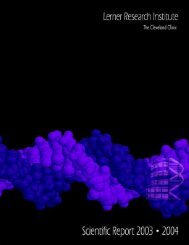Fall 2008 - Cleveland Clinic Lerner Research Institute
Fall 2008 - Cleveland Clinic Lerner Research Institute
Fall 2008 - Cleveland Clinic Lerner Research Institute
You also want an ePaper? Increase the reach of your titles
YUMPU automatically turns print PDFs into web optimized ePapers that Google loves.
<strong>Lerner</strong> research institute<strong>Institute</strong> Insider (continued)First, a primer in basic genetics. Cells are the building blocks ofthe body. Each cell in your body contains instructions encodedin your DNA that are parceled into 23 pairs of chromosomes.Approximately 39,000 genes, which are the instruction bookletsmade of DNA, are found dotted along all the chromosomes.Differences in people come from slight variations in these genes,which determine everything from hair and eye color to whetheror not a person is more or less susceptible to certain diseases.“There are several advantages to our innovation. First, the tight fitof the two rings make it extremely unlikely that tissue ingrowthwould occur to prevent the safe removal of the valve ring,” Dr.Fukamachi said. “The valve opening remains nearly normal sizebecause the base magnet is small and a simple design, so bloodflow is not obstructed as much. Finally, the coupling method hasthe potential for long-term durability.“If trials continue to be as successful as the first ones, weexpect repeat valve replacement surgeries to be easier and lesstime consuming compared to conventional valve replacements,”Dr. Fukamachi said. “Reducing the length of surgeries andthe amount of time on heart bypass machines is especiallyimportant for high-risk patients whose risk of death is increasedin those situations.”Corralling Enablers of Genetic MutationsGenetic mutations by themselves may not necessarily increasethe risk of developing certain cancers. Some genetic mutationsmay need enablers — little helpers that increase an individual’srisk of a genetic disorder.<strong>Institute</strong> researchers may have identified two of these enablersinvolved in cancer, a finding that could lead to advances in bothdiagnostic and preventive care for people who have certaingenetic mutations.Charis Eng, MD, PhD, Chair, Genomic Medicine <strong>Institute</strong>, hasidentified two tiny components of the human genome calledmicroRNA (miRNA) that appear to play an out-of-the-box rolein turning off a tumor-suppressing gene. With the tumor-fightinggene inactive, cells are more likely to grow uncontrollably andto cause cancers.The DNA in genes is translated or decoded into another geneticmaterial called messenger RNA. In turn, messenger RNA producesproteins that are the basic building blocks and workers of eachcell in the body. This conversion, of DNA to RNA to protein, isa tightly regulated process. Recent work, by many groups, hasdemonstrated that one regulatory player is the miRNAs. EachmiRNA provides a level of regulation to ensure that genes do notproduce too much or too little messenger RNA, which wouldresult in creating too much or too little cellular protein.Tumor suppressors are like the brakes of a cell. They tell thecell to stop dividing and growing at the right moment. Whena tumor suppressor gene is “turned off,” the cell’s brakes nolonger work, and unchecked growth and multiplication of cellscan occur, which often results in cancer. Dr. Eng’s group hasfound that two specific miRNAs — miR-19a and miR-21 —are associated with deactivating the tumor-suppressing genePTEN, which is involved in several types of cancer, as well asin Cowden syndrome. Cowden syndrome is an underdiagnosedheritable disorder associated with an increased risk ofdeveloping breast, thyroid and uterine cancers. In the firstpatient-oriented study of the two miRNA, Dr. Eng’s groupfound that the levels of these miRNAs are correlated to theamount of PTEN protein the cell produces.This is an exciting observation because it shows, for the firsttime, that despite having identical PTEN mutations, the PTENprotein levels can vary from individual to individual, dependingon their levels of these two miRNAs. And depending on themiRNA and PTEN protein levels, the severity of disease andthe cancer types can vary.“These miRNAs could serve as biomarkers that signal thepossibility of development of specific disease features. We thinkthat by understanding how miRNAs and the chromosomal genemutations talk to each other, we are one step closer to predictingprecisely what cancers develop and therefore personalizinghealthcare,” Dr. Eng said.22
















